Bully Hill Vineyards
by
Kathy and Terry Sullivan
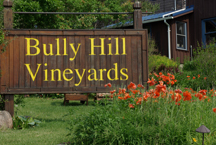 On a beautiful, sunny day, walking along a blacktop pathway, we passed colorful purple irises, lilies, Oriental poppies, gaillardia and daisies. Beyond the flowers, buildings comprising Bully Hill Vineyards sit, including the winery, gift shops, museum, tasting room and restaurant.
On a beautiful, sunny day, walking along a blacktop pathway, we passed colorful purple irises, lilies, Oriental poppies, gaillardia and daisies. Beyond the flowers, buildings comprising Bully Hill Vineyards sit, including the winery, gift shops, museum, tasting room and restaurant.
The Bully Hill name is attributed to English settlers from the 17th century. According to the story, there is a small town in Lincolnshire, England north of London named Bully Hill. When the settlers saw this area overlooking Keuka Lake, it reminded them of home and so they called it Bully Hill.
Walter Taylor founded the winery in the 1800’s on this spot. It was then called the Taylor Wine Company. The winery operations moved from Bully Hill to Hammondsport where it became the largest winery outside of California. Walter S. Taylor (Walter Taylor’s grandson) acquired the former Bully Hill property and began the Bully Hill Winery. The first vintage under the Bully Hill name was in 1967. Today Bully Hill Winery owns 800 acres of land with 120 acres of vineyards. Any grapes purchased are from local growers except for Merlot from Long Island.
We met Adam LaPierre, National Sales Manager, and he provided us with a wonderful tour and history of the winery. Adam mentioned that the winery system is efficient and mechanized. With only 20 full time employees, Bully Hill produces 150,000 cases. The tasting room sells about 14,000 cases or 10% of the wine and the other 90% is sold retail.
During fermentation, "must" sits in a barrel, and needs “punched” down. At Bully Hill one of two different weight plungers are used. Someone climbs a ladder, leans over the top of the tank and uses the plunger to punch the “must” down.
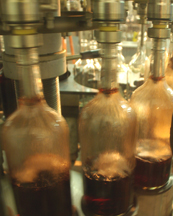 We had the opportunity to go into the bottling room. Before entering the enclosed room, we wiped our feet on a sanitizing solution. Anyone who enters the bottling room needs to do this. This was our first opportunity to see a large bottling machine in action. A worker removed empty bottles from cartons and placed them on a conveyor belt. The bottles traveled on the belt to a large circular machine that cleaned them. Next, the bottles traveled to the bottle-filling machine. After being filled, the bottles traveled to the cork or capping machine. The next machine placed a neck and cap label on the bottle and affixed it. Passing through a labeling machine, the bottles received both a front and back label. The last machine on the assembly line picked up the bottles and placed them in cartons. It was fascinating to watch the process.
We had the opportunity to go into the bottling room. Before entering the enclosed room, we wiped our feet on a sanitizing solution. Anyone who enters the bottling room needs to do this. This was our first opportunity to see a large bottling machine in action. A worker removed empty bottles from cartons and placed them on a conveyor belt. The bottles traveled on the belt to a large circular machine that cleaned them. Next, the bottles traveled to the bottle-filling machine. After being filled, the bottles traveled to the cork or capping machine. The next machine placed a neck and cap label on the bottle and affixed it. Passing through a labeling machine, the bottles received both a front and back label. The last machine on the assembly line picked up the bottles and placed them in cartons. It was fascinating to watch the process.
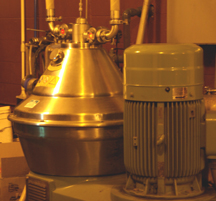 The next stop along the tour was where wine is filtered. Bully Hill uses a centrifugal force machine to separate suspended particles from the wine. This machine can remove many particles. The wine then passes through a filter. Next, we visited the two-onsite museums.
The next stop along the tour was where wine is filtered. Bully Hill uses a centrifugal force machine to separate suspended particles from the wine. This machine can remove many particles. The wine then passes through a filter. Next, we visited the two-onsite museums.
The first museum building is the Greyton Hoyt Wine Museum established in 1966. This museum has displays and artifacts from the beginning of the Taylor Wine Company. Check out the display on Prohibition and discover how the Taylor Wine Company survived those years. Walter Taylor started out in the wine industry as a cooper. There are many cooper artifacts and displays and one gets the sense that making a barrel was a laborious activity.
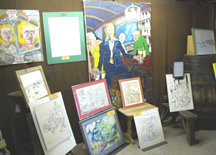 The second museum is an art gallery devoted to Walter S. Taylor who was an avid artist. Walter S. Taylor used his art to convey social concerns and events. While in this museum we met the Director, Paul Sprague. Paul gave us a detailed history of the Taylor Wine Company and how Walter S. Taylor began Bully Hill Winery. Paul spoke about the selling of Taylor Wine Company to Coca Cola Company and how Coca Cola forced Walter S. Taylor from using the Taylor name on his Bully Hill wine labels. This history is important because it helps the visitor to understand many of Walter S. Taylor’s paintings and watercolors. Over 500 paintings are catalogued and many are on display.
The second museum is an art gallery devoted to Walter S. Taylor who was an avid artist. Walter S. Taylor used his art to convey social concerns and events. While in this museum we met the Director, Paul Sprague. Paul gave us a detailed history of the Taylor Wine Company and how Walter S. Taylor began Bully Hill Winery. Paul spoke about the selling of Taylor Wine Company to Coca Cola Company and how Coca Cola forced Walter S. Taylor from using the Taylor name on his Bully Hill wine labels. This history is important because it helps the visitor to understand many of Walter S. Taylor’s paintings and watercolors. Over 500 paintings are catalogued and many are on display.
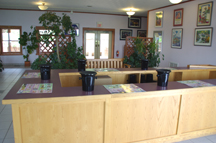 After our tour and visit to the onsite museums, we visited the tasting room where Adam suggested several wines. A display of the wine labels makes it easy to compare sugar levels. Rather than using residual sugar percentage, a line drawing under the label for each wine indicates the sugar level. This is an easy way to compare sugar levels.
After our tour and visit to the onsite museums, we visited the tasting room where Adam suggested several wines. A display of the wine labels makes it easy to compare sugar levels. Rather than using residual sugar percentage, a line drawing under the label for each wine indicates the sugar level. This is an easy way to compare sugar levels.
Many of the labels on the wine bottles are from the art that Walter S. Taylor painted. We noted three labels featuring a goat. These pictures were in reference to the dispute Walter had with the Coca-Cola Company. A judge ruled that Walter S. Taylor had to give all contraband labels with the word Taylor on them to Coca Cola. Taylor wrote the name Taylor on a goat but Coca Cola did not want the goat. The saying, “They can take my heritage and my name but they can’t take my goat,” became popular and the goat became a symbol of Bully Hill. Some wine labels were designed by Inger Bessman.
We tasted a new release Chardonel. This wine is from a Chardonel grape, which is a cross between Chardonnay and Seyval Blanc. Cornell developed this grape. It produces a fruit forward wine that is light and refreshing. Although dry, the fruit gives the hint of sweetness. The Chardonnay has a good balance between the fruit, acid and oak flavoring. The Riesling had a floral nose and fruit flavors. Felicity is a blend of Seyval Blanc, Delaware and Aurora. It is light and fruity. The Chambourcin is blended with 15% Pinot Noir. This is a fruit forward wine with light tannins. Someone who does not like red wine will like this Chambourcin. The Goat Red is the number one seller at Bully Hill, made from the Foch and Aurora grapes. It is sweet, fruity, and easy to drink.
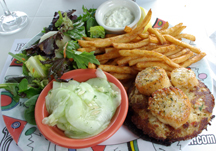 After the wine tasting, we had lunch at Bully Hill Restaurant. Choosing to eat on the deck, we enjoyed a lovely view of the lake. We began with cornbread and strawberry butter. For lunch, Terry ordered the crab cake and scallops over a portabella mushroom. The combination looked attractive and tasted great. Kathy ordered the turkey sandwich that was delicious.
After the wine tasting, we had lunch at Bully Hill Restaurant. Choosing to eat on the deck, we enjoyed a lovely view of the lake. We began with cornbread and strawberry butter. For lunch, Terry ordered the crab cake and scallops over a portabella mushroom. The combination looked attractive and tasted great. Kathy ordered the turkey sandwich that was delicious.
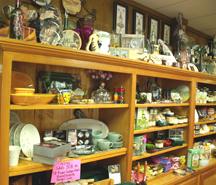 Many gifts are available for visitors to peruse. Visitors may find a special gift. The Bully Hill Vineyards gift shop has many quality items, including china, clothing, glassware and so much more. On the second floor is a holiday section. One could easily spend a couple of hours perusing the fine selections.
Many gifts are available for visitors to peruse. Visitors may find a special gift. The Bully Hill Vineyards gift shop has many quality items, including china, clothing, glassware and so much more. On the second floor is a holiday section. One could easily spend a couple of hours perusing the fine selections.
If possible, try to plan to stay an entire day when visiting Bully Hill Winery. There is so much to see, do and learn, having the extra time will offer a rewarding experience.
Bully Hill Vineyards
Hammondsport, New York
